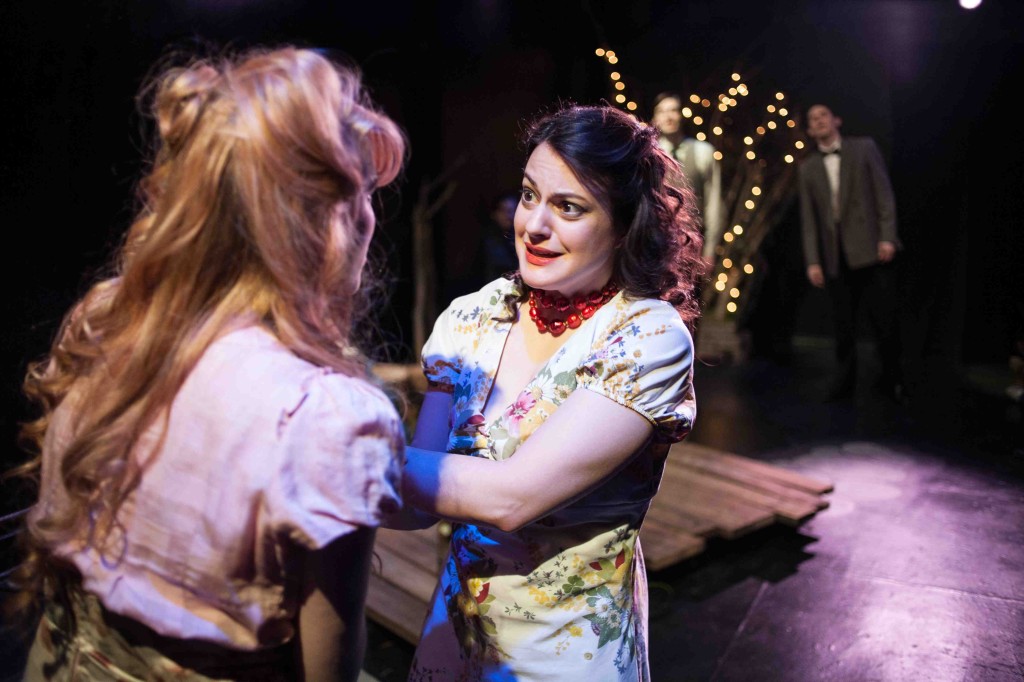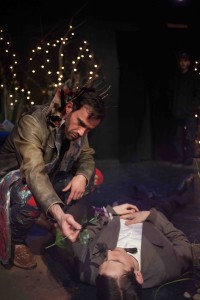Strangeloop closes its fifth season with a valiant attempt to bring the visceral passion of Shakespeare’s most popular comedy into the faces and hearts of modern audiences. Director Holly Robison sets A Midsummer Night’s Dream in 1940’s America, and more importantly brings the staging into promenade style: the audience is invited to sit anywhere and immerse themselves in the action.
Learning this was music to my proverbials, but I found this innovation to be somewhat underutilized in a frenzy-paced, superficial, but ultimately satisfying production of passion gone awry. I’m certainly not advocating the forced audience interaction of children’s theater, but I did feel the audience could have been used more often as silent confessor, source-of-opinion, or just an actual audience for characters who are very aware that they are not alone in such an intimate space. Helena (Mary-Kate Arnold) makes good use of the audience in her opening-scene soliloquy, but engagement quickly dwindled when we entered the Forest. All the same, anything that makes a play even slightly less cinematic is very welcome news to me (Immediacy is one of Strangeloop’s missions, which I support whole-heartedly).
The Forest itself was both simple and beautiful. Lauren Angel-Nichols’ design facilitated movement well, evoking enough realism to engage without turning the show into a museum pageant. The use of small, white Christmas lights on the bridge-like centerpiece and in a halo above (and dispersed elsewhere), whether the work of Nichols or lighting designer Eric Van Tassel, was a great decision: classic theater magic.
Carrie Campana’s costumes, likewise, were beautiful without distracting from performances. The three Types of characters were clearly demarcated, and the relatively vanilla color-palate of the Lovers’ clothes contrasted well with more elaborate Faerie costumes. In particular, Oberon’s long-jacket festooned with Faerie-isms was a nice melding of worlds and a welcome reminder that this is a play we’re watching, where magic is made out of reality, which I always enjoy. Even Bottom’s ass-head, though not the most impressive ever made, is functional and allows us clear access to the actor’s emotive face (a “realistic” ass-head that completely obscure’s Bottom’s face is only funny for about five seconds, and a burden for the rest of the show).
The story begins in the lobby, turning the audience into Duke Theseus’ court, as well as street-Athenians and even potential players for the Mechanicals’ Pyramus & Thisbe. The premise of Hermia’s engagement is laid out by a solid and very motivated Egeus (Kitty Mortland), who starts the play on a strong note. Unfortunately, this energy was quickly stonewalled by a thoroughly disinterested duke (Geoff Zimmerman, playing both Theseus and Oberon), who come-hell-or-high-water was not about to emotionally invest in the dilemma of Hermia’s marriage and potential death. This could be forgiven in the opening scene, where Theseus and Hypolita are noticeably more interested in each other, but it proved to be a recurring theme throughout the show.
But more about that later. The Lovers, by contrast, were passionately invested in themselves and each other, easily making them the highlight of the show (a smart move, since they have the largest roles). Tim Larson (Demetrius), Ken Miller (Lysander), Letitia Guillard (Hermia), and Mary-Kate Arnold (Helena); rather than wallow in wispy, lovelorn wonder, choose to pursue their desires with the intensity of life-and-death. It’s the lynch-pin of comedy, and most drama, for that matter. Some disservice has been done to this production, however, as the Lovers were evidently directed to deliver the majority of their lines at an insanely rapid pace. Immense amounts of poetry and textual value were skimmed over in the name of brevity: as much as I dislike cutting Shakespeare, I think I would have preferred excessive cuts to such inarticulate speed. Arnold’s Helena does provide some welcome variations in pitch, volume, and duration to great (and funny) effect; both Larson and Miller slow themselves when calm, but calm is a rare state with Midsummer’s Lovers. Luckily, Larson’s Demetrius gets to showcase some subtlety-chops near the end with the “But like a sickness did I loath this food” speech, and likewise Miller’s Lysander with his charmingly clumsy seduction of Hermia upon first entering the forest.
Perhaps (and this is entirely my supposition) the Lovers were ordered to such a fevered pace so that the historically crowd-pleasing Faeries and Mechanicals could take their time. In this particular production, however, I think that was a mistake.
The amount of sarcasm, bitterness, and snide superiority expressed by the Faeries and Mechanicals was, in a word, astonishing, as was the utter lack of playfulness, naivete, and/or passion that has served these roles so well in the past. It was certainly a new take, and the performances were believable, but virtually none of these characters seemed to care about what they were doing, nor anyone else onstage, nor really anything at all. Maria Burnham gives us a remarkably angry and callous Quince who, while very recognizable to modern audiences, seemed like inserting Mickey Mouse into Hamlet. I could not understand why she would cast such an overtly despised Bottom as Pyramus (Michael Houghton Wagman), why she would tolerate his presence, nor indeed why she was staging Pyramus & Thisbe in the first place. As I understand it, a Bottom who only cares about himself and thinks nothing of the performance or the other actors is standard faire, but I just don’t see the appeal of it. Bottom and Quince dominate the Mechanical scenes, and I consistently found myself asking why I should care about them at all when they have so little care for anyone or anything else. Maybe their admiration and/or need for each other was too well-masked for me to notice, but I don’t think Pinter meshes well with Midsummer Night’s Dream.
On the flip side, Naomi Lindh and Miona Lee (Flute/Peasblossom and Snug/Cobweb, respectively) created nervous and physically-informed Mechanicals who actually cared about the people around them. Lee’s Snug in particular seemed focused and invested every time onstage, ready to explode into action when given the chance/cue. Sadly, when dawning the guise of pixies, they become as jaded and uninvolved as everyone else. This must have been a directorial decision (given its overwhelming presence), but when the overreacting Lovers and under-reacting everyone-else are never onstage together, the contrast seems to serve little purpose. I was especially surprised that the Faeries, for whom it is easiest to justify stylized passion and wild abandon, were so constantly smirky, snide, cynical, un-animated, and uncaring.
All the same, Shakespeare is Shakespeare and always worth seeing and hearing. Kitty Mortland and Miona Lee are especially valuable assets (it’s a shame we don’t see and hear them more), and while I disagree very strongly with a lot of the choices made, all actors commit strongly to those choices, and a committed Shakespearean performance is always a triumph.


